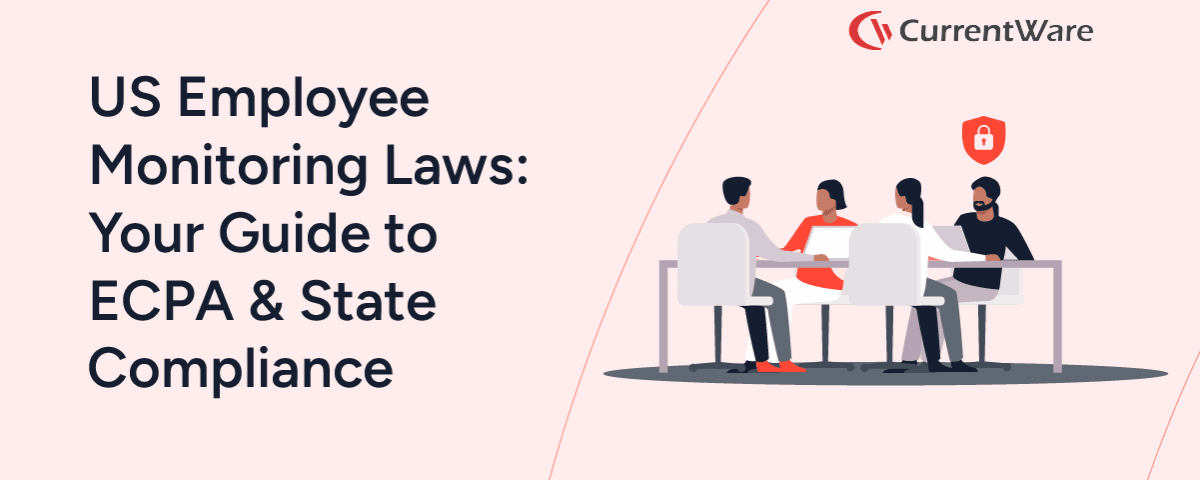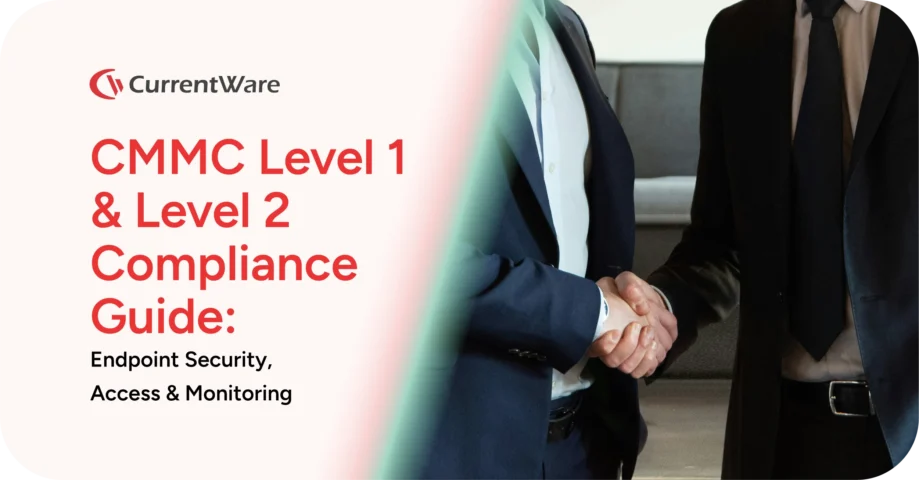US Employee Monitoring Laws: Your Guide to ECPA & State Compliance

Table of Contents
- 1: Modern Workplace Monitoring
- 2: ECPA and Workplace Monitoring: Navigating the Employer's Role
- 3: Beyond Federal: Critical State-Specific Consent Laws
- 4: CurrentWare's Solutions: Compliance Ready for Effective Monitoring
- 5: Understanding the ECPA: The Federal Baseline
- 6: ECPA's Evolution & Modern Limitations
- 7: The Future of ECPA and Proactive Insider Threat Prevention
- 8: Conclusion
- 9: Frequently Asked Questions
Disclaimer: For legal advice for your organization, it is always advisable to consult a legal professional specializing in electronic communications law.
Modern Workplace Monitoring
What is ECPA?
The Electronic Communications Privacy Act (ECPA) is a federal law designed to protect the privacy of wire, oral, and electronic communications. It remains a cornerstone of electronic communications privacy in the United States. However, its outdated framework struggles to keep pace with modern technology, from ubiquitous cloud-based tools to remote work platforms and IoT devices, creating a challenging compliance landscape for businesses.
What are the primary risks if my organization doesn't comply with employee monitoring laws?
Non-compliance can lead to severe consequences such as data breaches, hefty fines, and damage to your company's reputation. Specifically, under ECPA, non-compliance can result in fines up to $250,000, up to 5 years in prison, and substantial civil lawsuits for damages.
This article provides an in-depth exploration of the ECPA, its relevance to workplace monitoring, and the crucial nuances of state-specific consent laws. It also demonstrates how CurrentWare’s solutions empower organizations to navigate this complexity and prevent insider threats.
Also Read: Employee Monitoring Software for Productivity & Security
ECPA and Workplace Monitoring: Navigating the Employer's Role
How does the ECPA directly affect how my organization can monitor employees?
For organizations focused on insider threat prevention, the ECPA directly impacts how you monitor employee communications on company devices and networks. It governs access to employee emails, chats, and other electronic communications on work systems.
Under what conditions can employers legally monitor employee communications under ECPA?
Employers have two key exceptions that allow for monitoring under the ECPA:
- Consent: Employers can monitor if employees explicitly consent to monitoring. This is typically done through signed agreements during onboarding or clear policy acknowledgments.
- Ordinary Course of Business: Monitoring is permitted for legitimate business purposes (e.g., ensuring quality control, preventing data leaks, or maintaining system integrity) as long as employees are notified that such monitoring may occur.
What is the "tightrope walk" employers face when monitoring, and how can it be avoided?
The "tightrope walk" refers to the risk of breaching the ECPA if employers monitor personal communications without clear policies or explicit consent, potentially exposing businesses to legal and reputational risks. To avoid this, organizations must have clear policies and obtain explicit consent.
Also Read: Data Loss Prevention Software—Endpoint DLP Solutions
Start minimizing your software costs today.
Are you ready to start tracking software usage and start saving time and money?
Beyond Federal: Critical State-Specific Consent Laws
Four states have more stringent electronic monitoring legislation that often requires explicit notification or consent beyond federal stipulations.
| State | Consent Required? | Particulars | Recommended Action (Practical Guidance) |
| Connecticut | Yes (written notice) | Employers engaged in electronic monitoring (any non-direct observation) must give prior written notice to all affected employees. | Integrate clear, written notification into onboarding documents (e.g., employee handbook, AUP); prominently post notice in a conspicuous place readily available for viewing by employees. Obtain digital acknowledgment where possible. |
| Delaware | Yes (prior notice) | Employers must provide electronic notice daily or a one-time written/electronic notice acknowledged by the employee for electronic monitoring (phone, email, internet). | Provide prior written or electronic notice upon hiring; ensure employees acknowledge receipt electronically or in writing. Consider providing a daily electronic reminder when employees access employer-provided email or internet services as an additional safeguard. |
| New York | Yes (signed or electronic consent & posted notice) | Employers must provide written notice upon hiring and obtain signed/electronic acknowledgment when monitoring electronic communications (email, phone, internet activity). A notice must also be conspicuously posted in the workplace. | Require a signed or electronic consent form upon hiring that specifically addresses electronic monitoring; prominently post a notice in a conspicuous place viewable by all employees in the workplace. Conduct annual policy reviews with employees to reinforce understanding. |
| Texas | Yes (under state wiretap law for audio; best practice for all electronic) | Texas is a "one-party consent" state for audio recordings. While general electronic monitoring on company devices may not strictly require prior notice, best practice strongly advises explicit consent due to evolving privacy expectations and potential for broader interpretations. | Provide a comprehensive Acceptable Use Policy (AUP) outlining all electronic monitoring activities on company devices. Obtain explicit, written consent for all monitoring, especially if audio recording or any potentially sensitive data interception is involved. Reinforce no expectation of privacy on company systems. |
What is the overarching recommendation for organizations with employees in multiple states regarding monitoring policies?
Organizations with employees in these states, or any state, should deploy clear, comprehensive Acceptable Use Policies (AUPs) and obtain explicit, signed consent before activating any monitoring tools. This proactive approach ensures legal compliance and fosters transparency and trust with employees, safeguarding the organization from litigation and reputational damage.
CurrentWare's Solutions: Compliance Ready for Effective Monitoring
How can CurrentWare help my organization ensure compliance while monitoring employees for insider threats?
CurrentWare provides a comprehensive suite of tools specifically designed for insider threat prevention that enable effective monitoring while ensuring compliance with ECPA and state laws.
What are some actionable best practices for compliance that CurrentWare's tools support?
CurrentWare empowers the following actionable best practices:
- Develop a Transparent Privacy Policy: Create a clear policy outlining how electronic communications are monitored, stored, and accessed, and communicate it during onboarding and with regular reminders.
- Obtain Explicit, Informed Consent: Secure written consent from employees for monitoring, ideally during onboarding. Clearly explain that personal use of company devices may be subject to monitoring.
- Leverage CurrentWare's Compliance Ready Tools:
- BrowseControl (Web Filter & Application Blocker): Restricts access to unauthorized websites or applications, preventing non-compliant data access and reducing legal exposure.
- BrowseReporter (User Activity Monitoring): Provides visibility into employee internet and application usage, enabling proactive detection of insider threats while respecting employee privacy.
- AccessPatrol (Data Loss Prevention): Monitors and controls data transfers to prevent unauthorized sharing and exfiltration, supporting SCA compliance and safeguarding data at rest.
- Limit Data Access and Ensure Security: Restrict access to monitoring data to authorized personnel trained in ECPA compliance and your organization's privacy policies.
- Stay Proactive with Regulatory Updates: Regularly review monitoring policies to align with ECPA updates and other relevant regulations (e.g., GDPR, CCPA).
How does CurrentWare help with data retention and minimizing compliance risks?
CurrentWare offers automated data retention and deletion options, which are crucial for minimizing your data footprint and significantly mitigating the risk of non-compliance fines by ensuring data is not held beyond legal limits. This streamlines data lifecycle management and reduces your risk profile.
Also Read: Internet Usage Policy Guide: How to Create and Implement It?
Understanding the ECPA: The Federal Baseline
Enacted in 1986, before the internet era, it includes three key titles:
- Title I (Wiretap Act): Prohibits the unauthorized interception of real-time communications, such as live phone calls or emails in transit.
- Title II (Stored Communications Act - SCA): Protects electronic communications that are stored, like emails on a server or cloud data at rest.
Title III (Pen Register Act): Regulates the use of devices that track communication metadata, such as phone numbers dialed or IP addresses.
Has the ECPA been updated to keep pace with new technologies?
The ECPA has been amended over time to address new challenges, notably through the Communications Assistance for Law Enforcement Act (CALEA) of 1994 and the USA PATRIOT Act of 2001. However, despite these amendments, technological advancements, including widespread cloud storage, remote collaboration tools, and real-time geolocation data, have exposed significant limitations in its framework.
ECPA's Evolution & Modern Limitations
What are some of the key limitations of the ECPA in the face of modern technology?
The ECPA's framework struggles to keep pace with modern technology due to the ubiquity of cloud-based tools, remote work platforms, and IoT devices. Specifically, widespread cloud storage, remote collaboration tools, and real-time geolocation data have highlighted its limitations.
Are there any ongoing efforts to modernize the ECPA?
Yes, recent legislative efforts aim to modernize the ECPA. These include:
- Email Privacy Act: Passed by the House in 2016 but stalled in the Senate, this bill aimed for a warrant requirement for accessing all electronic communications, regardless of storage duration.
- ECPA Modernization Act: Proposed Senate bills seek to address ambiguities around cloud storage, geolocation data, and gag orders that prevent users from being notified of data requests.
What do these modernization efforts signal for businesses regarding privacy standards?
These legislative efforts clearly indicate a trend towards stricter privacy standards. The inconsistencies of the ECPA, amplified by global regulations like GDPR, create a complex compliance environment for businesses.
Also Read: BrowseReporter Employee Monitoring Software—Track PC Use
The Future of ECPA and Proactive Insider Threat Prevention
What are the key areas where the ECPA is expected to see future reforms?
The push for ECPA modernization continues, driven by advocacy and technological change. Proposed reforms aim to address critical areas such as:
- Cloud Storage: Ensuring warrant requirements for data stored in the cloud.
- Geolocation: Protecting real-time location tracking from warrantless access.
- Notice Requirements:: Limiting gag orders to ensure greater transparency with users.
CurrentWare is committed to evolving with the shifting regulatory landscape, providing adaptive tools necessary to stay compliant and secure.
Conclusion
Navigating the evolving landscape of ECPA and state-specific privacy is paramount for protecting your organization from costly insider threats and severe legal repercussions.
Beyond just compliance, how can CurrentWare help organizations in their monitoring efforts?
CurrentWare empowers organizations to go beyond mere compliance by enabling them to implement a robust, ethical monitoring framework that safeguards data, fosters employee trust, and provides peace of mind.
What is the final recommendation for organizations regarding their monitoring practices and legal advice?
Organizations are encouraged to assess their current monitoring practices and consider how CurrentWare’s innovative solutions can be integrated with their security posture to ensure unwavering ECPA adherence.
Protect, Comply, and Succeed
Frequently Asked Questions
- Title I (Wiretap Act): Prohibits the real-time interception of live wire, oral, or electronic communications.
- Title II (Stored Communications Act - SCA): Protects the privacy of communications that are in electronic storage, such as saved emails or files on a server.
- Title III (Pen Register Act): Regulates devices that capture metadata, like the phone numbers dialed or IP addresses contacted, without capturing the content of the communication.


